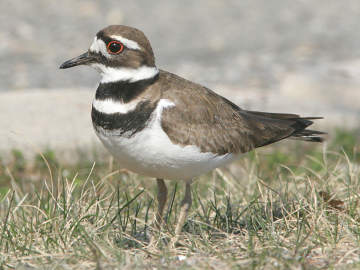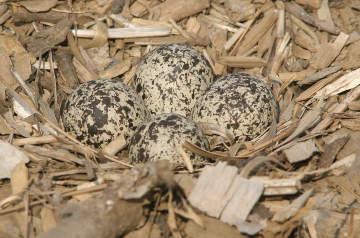

PHOTO COURTESY OF GARRY KESSLER
A killdeer. Male and female look similar.
July 28, 2017, Page A8
NATURE NOTES
By Annie Reid
Westborough Community Land Trust
An act that is hard to miss
Have you ever seen a bird do a broken-wing act? We’ve all heard of it, and it’s hard to miss when it happens. One of our summer birds with an odd name, the killdeer, is well known for it.
That’s because killdeers (Charadrius vociferus) tend to nest right on the ground in certain kinds of open areas that people have created, so it’s easy to set off a broken-wing act if you happen to wander too close to the nest. Be on the lookout for killdeers if you’re walking near a recently plowed field or recently dug garden, a golf course, a grassy athletic field, or even a low building (such as a school) with a flat gravel roof.
The broken-wing act includes a lot of noisy calling, to attract your attention of course. A parent bird, either male or female, hurries along the ground, away from the nest, with tail spread and a wing dragging in way that feigns an injury. The idea is to get a would-be predator – that’s you – to follow in hopes of an easy catch. The whole point of the display is to lead the predator away from the nest. Often the other parent bird is nearby, also calling frantically. Predators include foxes, dogs, raccoons, skunks, hawks, crows, and snakes.

PHOTO COURTESY OF GARRY KESSLER
Killdeer nest among wood chips at a local community garden.
The nest is hardly what we usually think of as a nest. It’s a scrape in the ground – a slight depression created when the birds settle into a chosen spot and wriggle around. Once the eggs are laid – usually four – the killdeer pair adds a few items, such as bits of gravel, often white. The whole thing, complete with eggs, is well camouflaged against the surrounding ground, so you’ll probably have a hard time spotting the nest that you got too close to. Be careful where you step.
Killdeers need to protect their nest for about three weeks – a relatively long time – while the chicks develop inside the eggs. But once they hatch, the chicks are up and out as soon as their down is dry. The chicks can see, walk, run, and pick up food. The parents lead them away from the nest area. And it’s a good thing, too, because live, moving chicks would be much more obvious to any predator than the nest and eggs. The parents don’t even need to feed their chicks. The parents just lead them to good places to forage for insects and worms. The parents also watch for danger and give alarm calls that tell the chicks to hide or to freeze in place. After three or four weeks, the chicks are finally able to fly, and then they’re on their own.
If you get a good look at a killdeer, you’ll see that it seems boldly patterned, with two dark stripes across the breast, but its markings actually help to camouflage the bird by breaking up its image. If you’ve spent time at the seashore, the killdeer’s patterns might remind you of shorebirds you’ve seen, such as certain plovers. That’s not surprising, since plovers are close relatives of killdeers. The plovers are somewhat smaller than killdeers and have one dark breast band rather than two.
Walking around our area, far from the seashore, you might be tipped off to the presence of a killdeer by its calls (listen at www.allaboutbirds.org/guide/Killdeer/sounds). Apparently some calls sound like “kill deer” and are the source of the bird’s name, but not everyone hears those words in the calls. Killdeer are among the birds that do well living near humans and in the open environments that we’ve created. But now they – and various other birds – may be becoming less numerous in our area as agricultural fields disappear. They also may be at risk from mowing and pesticides used on lawns and golf courses.
Enjoy watching and listening for killdeer from April when they arrive through late summer when they leave.